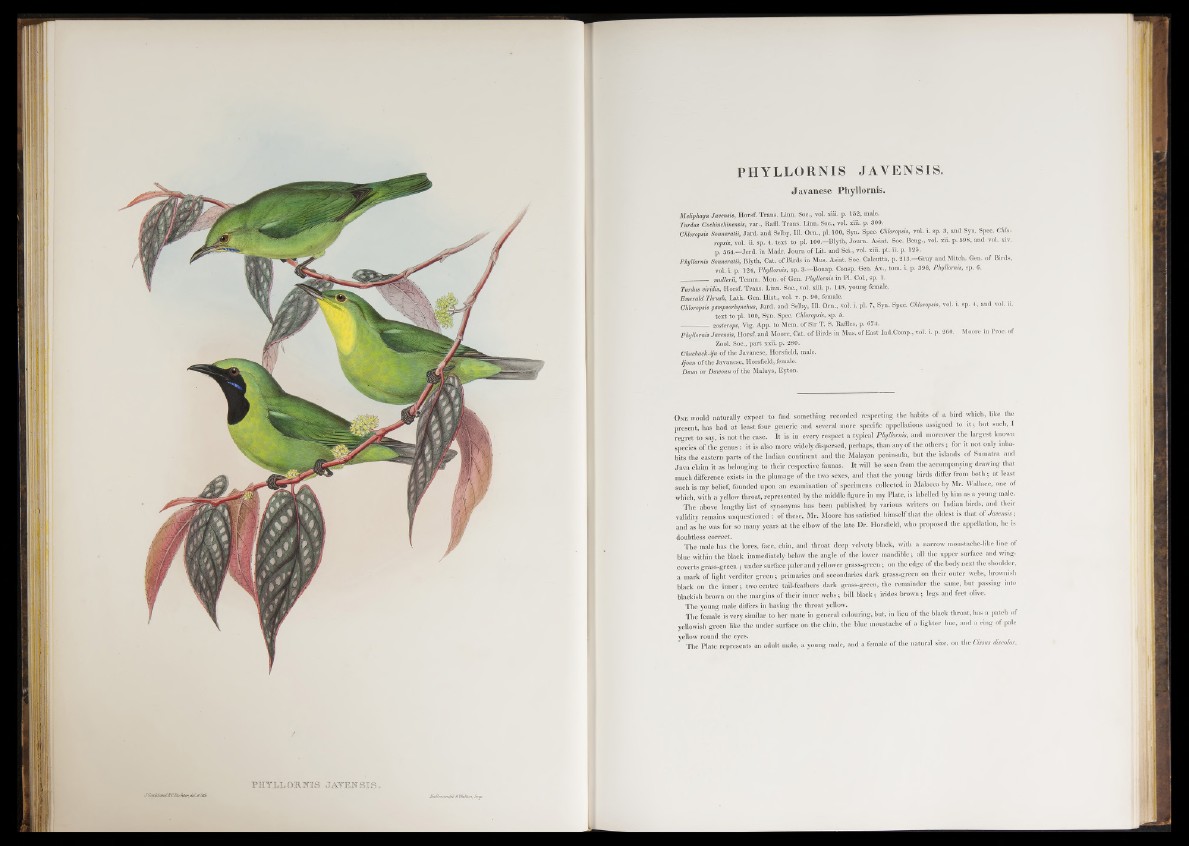
PHYJLLORWIS JAYEBTSIS.
£Gbu&ia?uU£Clizc7i£cr,deL&Zi&L
Javanese Phyllornis.
Meliphaga Javensis, Horsf. Trans. Linn. Soc., vol. xiii. p. 152, male.
Turdus Cochinchinensis, var., Raffl. Trans. Linn. Soc., vol. xiii. p. 309.
Chloropsis Someratii, Jard. and Selby, IU. Om., pi. 100, Syn. Spec. Chloropsis, vol. i. sp. 3, and Syn. Spec. Chloropsis,
vol. ii. sp. 4. text to pi. 1 0 0— Blytb, Joum. Asiat. Soc. Beng., vol. xii. p. 598, and vol. xiv.
p. 564.—Jerd. in Madr. Joum of Lit. and Sci., vol. xiii. pt. ii. p. 125.
Phyllornis Someratii, Blyth, Cat. o f Birds in Mus. Asiat. Soc. Calcutta, p. 2 1 3 .-G ra y and Mitch. Gen. of Birds,
vol. i. p. 124, Phyllornis, sp. 3.—Bonap. Consp. Gen. Av., tom. i. p. 396, Phyllornis, sp. 6.
—------— jmllerii, Temm. Mon. of Gen. Phyllornis in PI. Col., sp. 1.
Turdus viridis, Horsf. Trans. Linn. Soc., vol. xiii. p. 148, young female.
Emerald Thrush, Lath. Gen. Hist., vol. v. p. 90, female.
Chloropsis gampsorhynchus, Jard. and Selby, 111. Om., vol. i. pi. 7, Syn. Spec. Chloropsis, vol. i. sp. 4, and vol. ii.
text to pi. 100, Syn. Spec. Chloropsis, sp. 5.
------------- zosterops, Vig. App. to Mem. o f Sir T. S. Raffles, p. 674.
Phyllornis Javensis, Horsf. and Moore, Oat. o f Birds in Mus. o f East Ind.Comp., vol. i. p. 260. Moore in Proc. of
Zool. Soc., part xxii. p. 280.
Chuchack-iju o f the Javanese, Horsfield, male.
Jjoan of the Javanese, Horsfield, female.
D am or Dawoun o f the Malays, Eyton.
One would naturally expect to find something recorded respecting the habits of a bird which, like the
present, has had at least four generic and several more specific appellations assigned to i t ; but such, I
regret to say, is not the case. I t is in every respect a typical Phyllornis, and moreover the largest known
species of the genus : it is also more widely dispersed, perhaps, than any of the o th ers ; for it not only inhabits
the eastern parts of the Indian continent and the Malayan peninsula, but the islands of Sumatra and
Java claim it as belonging to their respective faunas. It will be seen from the accompanying drawing that
much difference exists in the plumage of the two sexes, and that the young birds differ from bo th ; at least
such is my belief, founded upon an examination o f specimens collected in Malacca by Mr. Wallace, one of
which, with a yellow throat, represented by the middle figure in my Plate, is labelled by him as a young male.
The above lengthy list of synonyms has been published by various writers on Indian birds, and their
validity remains unquestioned : of these, Mr. Moore has satisfied himself that the oldest is that of .Javensis;
and as he was for so many years a t the elbow of the late Dr. Horsfield, who proposed the appellation, he is
doubtless correct.
The male has the lores, face, chin, and throat deep velvety black, with a narrow moustache-like line pf
blue within the black immediately below the angle of the lower mandible; all the upper surface and wing-
coverts grass-green ; under surface paler and yellower grass-green; on the edge of the body next the shoulder,
a mark of light verditer g ree n ; primaries and secondaries dark grass-green on their outer webs, brownish
black on the in n er; two centre tail-feathers dark grass-green, the remainder the same, but passing into
blackish brown on the margins of their inner webs; bill black; irides brown; legs and feet olive.
The young male differs in having the throat yellow.
The female is very similar to her mate in general colouring, but, in lieu of the black throat, has a patch of
yellowish green like the under surface on the chin, the blue moustache of a lighter hue, and a ring of pale
yellow round the eyes.
The Plate represents an adult male, a young male, and a female of the natural size, on the Ctssus discolor.